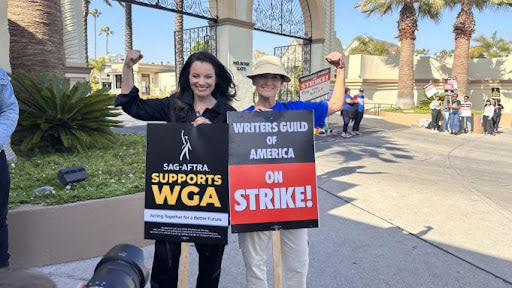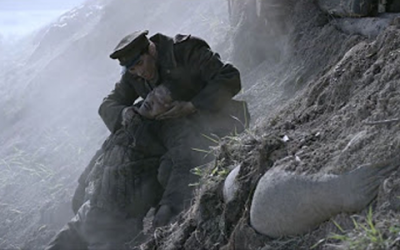Source: Variety
What could possibly be more frustrating for one of the world’s most prominent filmmaking industries than a strike that forces the majority of its productions to a standstill? How about a second strike that forces even more of its productions to a standstill? While Hollywood has yet to reach that point, it’s quite possible it will within the next couple weeks. At the moment, the thousands of people that make up the Writers Guild of America (WGA) are picketing in the streets demanding a better deal for those who write the business’ countless film and television scripts, the result of the Alliance of Motion Picture and Television Producers (AMPTP) inability to provide a satisfactory agreement for the WGA. This strike is already costing studios like Disney and Warner Bros. several millions of dollars, much more than they would be giving up it they were willing to agree to the WGA’s terms, and that number is expected to only grow with each passing day. As if the Writers’ strike wasn’t enough though, these same studios could soon have to contend with another strike from an even more prominent labor union, that being the Screen Actors Guild – American Federation of Television and Radio Artists (SAG-AFTRA) and its roughly 160,000 members (for comparison, the WGA only consists of around 15,000 members). Whatever toll the Writers’ strike is taking on the film industry would only skyrocket with the addition of SAG-AFTRA into the mix, and unless it and AMPTP are willing to reach a strong enough agreement in the next few weeks, that’s almost precisely what will happen.
On Wednesday, May 17th, SAG-AFTRA released a public statement claiming that it will be holding a strike authorization vote sometime before June 7th, the day it’s currently set to engage in negotiations with the studios. While the vote will not necessarily make it certain that the union’s tens of thousands of members will join the striking WGA in the streets once its current contract expires on June 30th, it will give SAG-AFTRA what it describes as “maximum bargaining leverage” as it discusses its terms with the AMPTP. “We must get all our ducks in a row should the need present itself,” states current SAG-AFTRA president Fran Drescher. “The prospect of a strike is not a first option, but a last resort. As my dad always says, ‘Better to have and not need than to need and not have!’”
The last time in which the threat of a SAG-AFTRA strike authorization vote came was in 2017 following claims from the union that the AMPTP sought “outrageous rollbacks” that would have undoubtedly had a significant effect on the guild. Fortunately, both sides of the conflict were able to come to a satisfactory agreement, and a note vote to authorize a strike was needed. One vote that did occur took place in 2018 vote and involved those who worked in television animation. The vote saw 98% of those participating agree to go on strike if necessary, but a deal reached two months later also resulted in there being no need for a strike.
Much has changed in the time since both of those votes however, so much so that there appears to be a significantly stronger desire for SAG-AFTRA to go on strike. With only three weeks before the beginning of negotiations and the expiration of the current contract, both sides have only so much time to come to an agreement and avert a second industry-stopping shutdown. This is why SAG-AFTRA is beginning its strike authorization vote as soon as possible: so it can gain leverage over AMPTP without having to lose too much time. The ongoing WGA strike has likewise given SAG-AFTRA an advantage by providing an example of what can happen if the actors’ guild and the studios cannot create a satisfying contract. Still, that might be easier said than done given that some of SAG-AFTRA’s priorities don’t entirely line up with those of the WGA, even though both unions seem to strongly support one another. “I don’t think what’s very important to writers — and I’m a writer too in the WGA — is the kind of stuff that we’re going after,” Drescher, who has also made appearances in the WGA picket lines from time to time, claims. “Although I’m very empathic for their needs to be honored, I feel like our conversation is going to be very different. And I feel very hopeful that maybe we won’t get to this point.”
What are the issues that SAG-AFTRA intends to bring to the forefront once it begins talks with AMPTP? As it turns out, they’re many of the same issues that have caused the WGA to go on strike. For starters, there’s the demand for wage increases; due to the inflation that has occurred over the years, many actors who receive scale pay believe the current minimum to be too small of a number of which they can make a decent living, and they hope these upcoming talks will see a sufficient raise for all those associated with the union. Streaming residuals are also a major point of contention for SAG-AFTRA; many services like Netflix and Disney+ do not currently make the data regarding subscriber numbers and viewership of content publicly available, which makes it difficult to determine how much residual payment those involved in production should receive. SAG-AFTRA seeks to change that in its negotiations with the studios, and it also hopes to change how artificial intelligence programs that can replicate an actor’s image are used by the studios, a situation that raises various ethical questions regarding how, if at all, an actor should be recreated with digital means without providing the original actor with just compensation. Lastly, the union will draw some attention to the move towards “self-tape” auditions, which involves actors filming themselves in order to audition for a given role. Many performers consider this process to be “costly and burdensome” and wish to return to a more traditional means of auditioning.
Will SAG-AFTRA’s demands be fulfilled in their upcoming talks with the AMPTP? Or will they only be further encouraged to go on strike and join the WGA in the streets? With a little over a month before the union’s current contract reaches its expiration date, there’s still quite a bit that can happen before and during these upcoming talks, but if the current environment is any indication, one should prepare for a second, even larger strike to come into formation and force the American film industry to yet another standstill.




